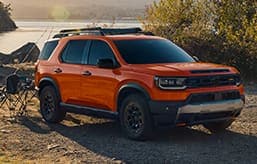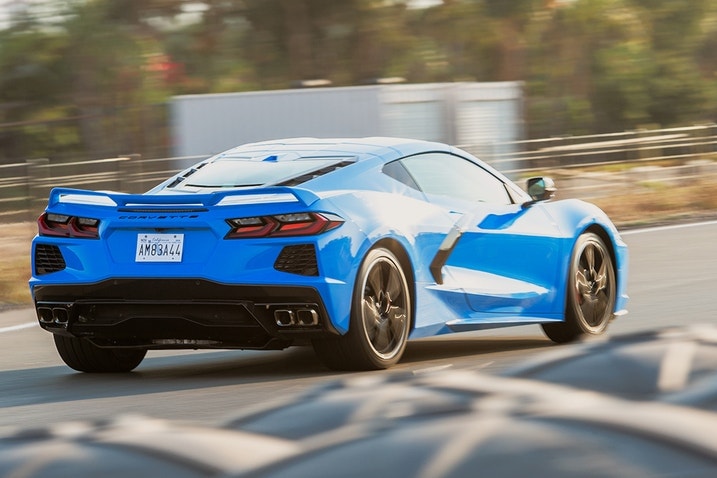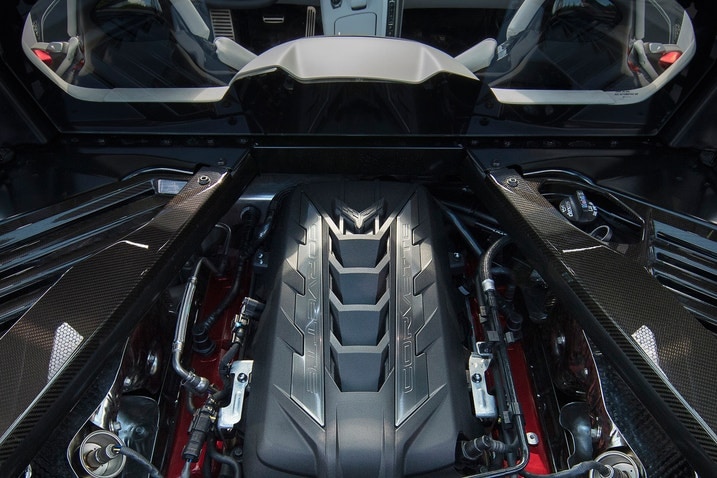- We spent three years and 32,000 miles with a Chevrolet Corvette Stingray.
- The Corvette remains one of the best-driving sports cars on the road today.
- Maintenance costs were high, and service intervals can be short if you often track the car.
The Chevy Corvette Is Gone From Our Long-Term Fleet But Not Our Hearts
We say goodbye to the most revolutionary Corvette since 1953
Back in July 2019, the world got its first look at the long-awaited mid-engine Chevrolet Corvette. The eighth-generation model was the most radical change to the Corvette since its introduction in 1953. The move had been anticipated for years; Chevy's engineers have never been cagey about their desire to move to a mid-engine platform given the performance benefits, and there have been mid-engine concept cars and prototypes dating back decades. What was shocking was the starting price of about $60,000, seemingly a bargain for what Chevrolet was offering.
This isn't the first Corvette Edmunds has had in its long-term fleet. We bought the C7 Corvette Stingray (one word) when it went on sale in 2014 and owned a C5 Corvette Z06 prior to that. There was also a 1966 Corvette Sting Ray (two words) in our fleet, too. (It's still hanging around our office somewhere.) Given how exciting the new C8 Stingray looked on paper, adding one to our long-term fleet was a no-brainer.
When it comes to Corvettes, performance is always a given. There was little doubt that the C8 would be great to drive, but how would it be to live with on a day-to-day basis? Corvettes have always been sports cars that were easy to live with every day. The cargo area was big, the ride was comfortable, and the V8 wasn't too thirsty. Corvette owners love talking about how great their fuel economy is.
It turns out there was little reason to worry. The C8 ended up being a staff favorite, sticking around for far longer than most of our other long-term cars because we simply kept wanting to drive it. Our Stingray did everything from road trips to racing, and ownership was (mostly) trouble-free. Three years, three windshields, four sets of tires, and more than 31,000 miles later, we finally said our goodbyes. The Edmunds garage is all the poorer for it.
What we got
Since the C8's debut, Chevy has added a few new variants to the Corvette lineup — the hybrid Corvette E-Ray and the wicked, track-ready Corvette Z06 — but when we bought our car only the base Stingray was available. The base price at the time was $59,995 (though the Corvette's starting MSRP is closer to $70,000 in 2024), a heck of a bargain and tens of thousands less than a car like the Porsche 911 Carrera.
The Stingray is powered by a 6.2-liter naturally aspirated V8 (490 horsepower, 465 lb-ft of torque) paired with an eight-speed dual-clutch transmission that sends power to the rear wheels. This is the first Corvette with a dual-clutch transmission. It's also the first Corvette without an available manual transmission.
We opted for the midlevel 2LT trim, a $7,300 leap over the base model. Standard features included wireless phone charging, Apple CarPlay and Android Auto, a head-up display, driver aids including blind-spot monitoring, and an exterior camera for watching curbs. Arguably the best decision we made when speccing our Corvette was the addition of the $1,495 nose-lift system. One push of a button will raise the car's nose slightly to help better clear driveways or speed bumps. You can even set GPS geotags that will automatically trigger the nose lift in those areas.
In addition to the nose lift, another must-have feature for us was the Z51 performance package. At $5,000, it wasn't cheap, but the benefits in performance were well worth the cost. The Z51 package includes an electronically controlled limited-slip differential, an upgraded exhaust that adds 5 hp (for a total of 495 hp in our car), Michelin Pilot Sport run-flat summer tires, and performance-oriented brakes and cooling. Opting for the Z51 package allowed us to add the MagneRide and Performance Traction Management option ($1,895) to our car. The package included adaptive dampers and an enhanced stability control system to help us drive faster.
Other options on our car include Rapid Blue paint ($500), red brake calipers ($595), red seat belts ($395) and the Engine Appearance package ($995). The latter includes LED lights and carbon-fiber trim in the engine bay. All in, we paid $80,660 for our 2020 Stingray.
What we liked
First and foremost is the Corvette's performance. This is simply one of the best-driving sports cars on the road today. The engine, steering, brakes and suspension all left us impressed. Senior manager of written content Brent Romans wrote, "Put your foot in it and this thing just rips. 495 hp, stock, right out of the gate from the first year of production. I have a friend who wants to wait to buy the rumored Z06. While I salute him and all, I must admit that I don't feel the need for more speed with our Corvette. Why? 1) It's plenty fast; 0-60 in 3.4 seconds and the quarter mile in 11.5 seconds. And 2) it's one of those cars that whispers in your ear, 'C'mon, mate, go faster!' It's a speeding ticket-generating machine as it is. I'd have no problem buying a base Corvette."
The car felt more stable at the limit and easier to drive than both past Corvettes and some other mid-engine cars. An editor noted that drifting was less work than he expected. "Mid-engine cars generally rotate quickly and can be difficult to catch in an oversteer. Historically, Corvettes haven't been great for drifting either; previous generations offered very small windows to catch them with countersteer and minimal amount of slip. None of this is true with the C8. It took two or three attempts to build confidence, but once I figured it out, I realized how easy it was: Approach the corner fast and hard on the racing line, turn in quickly to begin unloading the rear, and muscle the gas pedal to promote the powerslide. No flick needed."
The Corvette continues to be a great sports car to use every day. One driver noted that "no matter how people go on about the performance and handling, the thing that continually impresses me about the C8 is the ride quality. There is no more comfortable sports car on sale today than the Chevrolet Corvette."
That same sentiment carried over on a long road trip in the C8. "The new mid-engine Corvette is relentlessly comfortable on long road trips. In five days of driving the C8, over 2,200 miles, I never once got legitimately uncomfortable. The ride quality, even over bumpy surfaces, is totally forgiving, while the seats are well-padded and well-bolstered."
The cargo area, while down about 20% in total area compared to the previous Corvette, still proved sizable enough for groceries, golf clubs and luggage. "Combine the small, duffel-bag-sized frunk and the wide-but-deep trunk in the C8, and you've got quite a bit of cargo space for road trips. I was able to fit all my bags easily, with room to spare, for a five-day trip and I don't pack lightly." And don't worry; like all Corvettes from the C4 onward, the removable targa roof panel stores neatly in the trunk, though it does limit the cargo area when it's being stored. It's light enough to be removed by a single person too.
One consistent throughline has been praise for the Corvette's optional nose lift. It's maybe the one thing everyone agreed was great about the Corvette. "Favorite feature on our Corvette? By far, the front suspension lift," one staffer wrote. "As a former C6 owner, I had to deal with the scrrrckkk sound of my car's plastic underbody air dam scraping on my driveway every time I backed out of my driveway. Now I can just lift the front end with a push of a button or, better yet, program it into the navigation system so that it does it automatically when I approach my driveway. Brilliant!"
Some other highlights include general build quality. The interior held up much better than we've seen in past Corvettes. We like that Chevrolet supplies camber settings for track use right in the manual. You can take your car to a dealer to adjust it, though once we set it we left it in the track alignment all of the time, tire life be damned. The Corvette's fuel economy, while not exactly stellar, was just about right on its EPA-estimated figure. That was a bit of a surprise given how the Corvette has been driven while we've owned it.
What we didn't
The list of cons for the Corvette was far shorter than its pros. Taller drivers like news manager Cameron Rogers found it to be a bit tight inside. "The cabin is on the small side, and given my body's silly proportions, I have to make some sacrifices in order to fit. This means choosing between scooching closer to the wheel so my head isn't butting up against the roof, or moving the seat back and propping my head against the roof's metal crossbar. I usually opt for less legroom/more headroom."
Senior vehicle test editor Kurt Niebuhr noted that the car sounds clattery and diesel-like at idle because of the engine's direct-injection system. "It's a constant fluttery ticking sound that's audible at low speeds or at a stop. This is what [direct injection] does and this is how it sounds. The difference with the C8, as opposed to most every other car that uses it, is that you can hear it so clearly inside the car. And it's very audible at idle and at low speeds, so, like, everyday traffic. Why? Good question! If I had to hazard a guess, I'd put my money on the need to leave the engine exposed and the subsequent lack of insulation that would render the ticking inaudible. I'm surprised Chevy didn't deploy some auditory countermeasures (a white noise generator) to tone it down." Kurt's sentiments were echoed by others on staff, though no one had any complaints about the noise when the engine was really cooking.
Some other downsides were the interior design. Some of us found the long row of buttons for major controls to be busy and a bit tacked-on, though others appreciated the use of real buttons and knobs rather than locking all the functions in a touchscreen. The reduced cargo area was disappointing as Corvettes have long offered a fairly generous amount of storage for a sports car.
Cost to own
Maintenance and upkeep can be pricey. Since we bought the Corvette, we've had to replace three windshields, install four sets of tires, and were forced to replace a few wheels. Now, the windshields, two of the wheels, and three sets of tires were not the Corvette's fault. Punctures, potholes and some aggressive use of curbing on a racetrack were the main culprits behind the blown tires and bent wheels. One set of tires was replaced due to normal wear, and one of the wheels was replaced when an inspection at the dealer showed our car suffered from a known manufacturing defect. The windshields? Well, those are on us. In total, we spent $1,190 to replace the two bent wheels, $2,022 to replace three windshields, and $5,041 in Michelin rubber.
Regular service visits weren't exactly cheap either. We followed the "severe" service schedule because of a combination of track use and primarily city-based driving. That meant our first oil change occurred at 4,800 miles, a few thousand miles before the regular service interval. That first oil change was covered by Chevrolet, but subsequent service visits were not. That included another oil change plus a transmission service at about 7,500 miles. That set us back $768.71 for a transmission filter, a quart of transmission fluid, and 2.5 hours of labor at the dealer. You could theoretically do the service yourself, but accessing the filler neck for the transmission is a bit difficult. Over 32,000 miles of ownership, we spent a total of $1,283 on regular service visits. When you add in the cost of repairs and tires, we spent a total $9,536 on maintenance.
But that only tells part of the story. We originally paid $80,660 for our C8 and sold it for $61,000 for a total of 24% depreciation. That figure, along with the cost of repairs and maintenance, means it cost us $29,196 to own the Corvette (not including the price of fuel).
Would we do it again? In a heartbeat.
Edmunds says
The C8 Corvette is a radical departure from the car it replaced, though it still delivers on nearly all fronts. It's faster, easier to drive and more comfortable than ever before. Given its price, the Corvette still punches well above its weight in terms of performance. We're split on some of the design choices both inside and out, but no one was ever disappointed to grab the keys to the Corvette for a night. So long, C8.
















 by
by